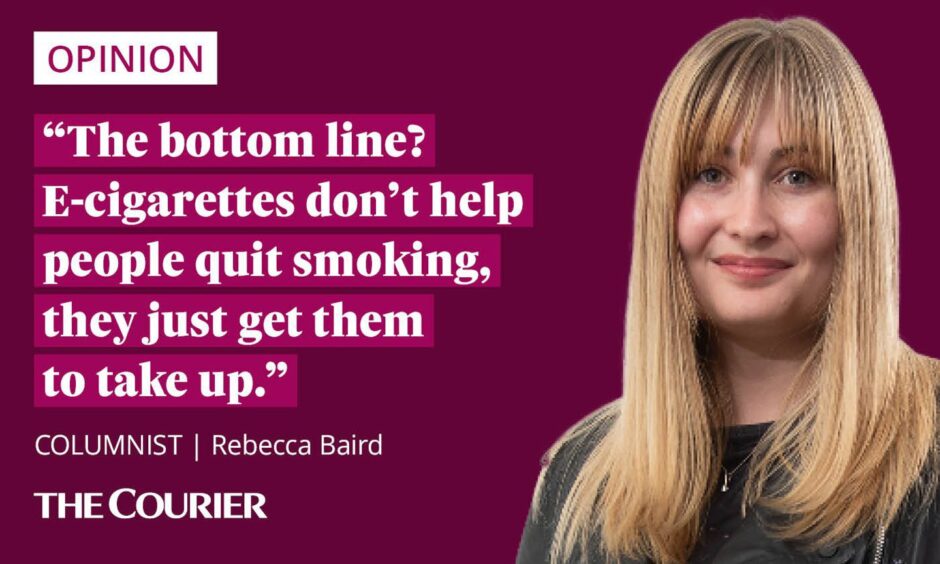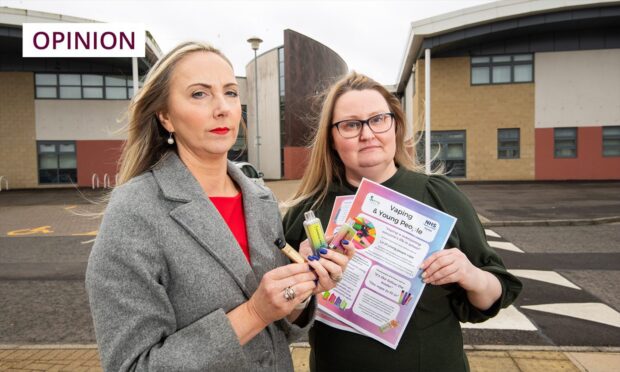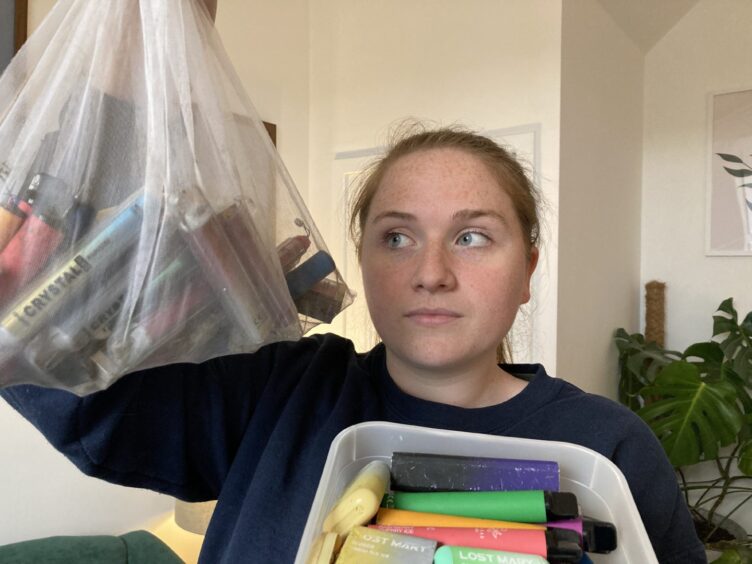Remember that famous photo of the nine-year-old girl smoking in an inflatable paddling pool?
It was taken in 1990 by American photographer Mary Ellen Mark, a total rock star of a photojournalist who documented marginalised communities across the world.
It was, and still is, an uncomfortable photo to look at. And we may comfort ourselves by saying ‘but that was over 30 years ago’.
Yet swap out the cigarette for an e-cig and the photo could’ve been taken in Dundee today.
This week, The Courier revealed that children as young as seven have been reported vaping at school in Dundee.
And though we don’t have a photo like Mark’s, the mental image of sickly-sweet cloud billowing out from a mouthful of baby teeth is bad enough.
I think back to my pals passing out fake candy cigarettes on the playground in the noughties, and how we’d pretend to smoke them, feeling so big and bad.
And how those sweets – which were truly just sweets – were banned over fears that they would encourage children to take up smoking later in life.
That seems so innocent now.
And reading this week’s report, I found myself thinking: How did we get here?
Kids getting hooked on vapes was inevitable
But actually, it’s no surprise that children are getting hooked on e-cigarettes.
Much like the energy juice craze of my generation, they combine an addictive substance (nicotine), candy-inspired flavours and eye-catching packaging.
So it seems inevitable that vaping would make its way into our primary schools, the same way the energy juice did, and the cigarettes before that.
But it’s not enough to ban the cheap single-use vapes; we need a total attitude overhaul.
Because what’s most alarming to me about this particular generation’s rite-of-passage into illicit substances is that their parents are not united in opposition to it.

In fact, some are condoning it, with the logic that it’s better than kids taking up smoking tobacco.
However, in 2022 cigarette smoking levels in 15-year-olds hit an all time low, with just 11% reported smoking on a regular basis.
Meanwhile in the same year, nearly 15% of 15-year-olds reported current vape use.
And the Ash Scotland study reported that ‘e-cigarette use primarily occurs in regular and occasional (tobacco) smokers in both 13- and 15-year-olds’, which stubs out the idea that kids who vape are less likely to smoke.
Vaping is not replacing smoking; it’s just an alternative flavour of addiction.
‘Lesser evil’ thinking is the real danger
And even supposing all those teenage smokers were also the ones vaping, there’s still an extra 4% of kids who are exclusively vaping – probably because it’s seen as a safer option.
Yet it’s one that’s still so new, we can’t possibly know what all the long-term health effects are. To me, that’s just as terrifying as the known risks of smoking.
So why are parents stuck on this ‘lesser evil’ thinking?
Well, because that’s the rumour that’s been sold to everyone, not just to kids.
Vapes have been marketed as a smoking cessation tool, and many smokers took up vaping in good faith that it would help them quit.
It makes sense in theory – vaping allows for all the same routines as smoking, and gives that nicotine hit, without all those ‘harmful chemicals’.
Except that there are harmful chemicals in vapes; they’re just different, and in much smaller quantities.
There’s acrolein (a herbicide used to kill weeds), benzene (which you’d find in an average car exhaust), formaldehyde and acetaldehyde (both proven to increase cancer risk) and propylene glycol, a popular ingredient in paint stripper and antifreeze.
And now, a few years down the line, the evidence is beginning to show what can be anecdotally observed by looking in any Dundee city centre bin – that vaping isn’t a solution to smoking.
Time to make vapes prescription-only
Sure, compared to other methods such as nicotine patches and gum, e-cigarettes have slightly more (around 8%) of a success rate when it comes to helping smokers quit.
But that figure, from University of Sydney researchers, becomes bleak when you realise that vapes have ‘only’ an 82% failure rate in helping folk quit, as opposed to a 90% failure rate for other nicotine replacement methods.
The bottom line? E-cigarettes don’t help people quit smoking, they just get them to take up vaping.
“Wait!” I hear you protesting: “What about the 18% for whom it does work?”
Easy: prescription-only vapes.
If the existence of this nuisance product, which is a blight on the environment as well as Scotland’s classrooms, is being justified by the idea that it has some medical benefit, then fine – make it a medical product.
Vapes can be dispensed to smokers looking to quit from pharmacies, and taken off the shelves in shops.
You wouldn’t give your child methadone because it’s better than them using heroin.
So it’s time for Dundee to stop normalising this city-wide addiction, and get vapes off shop shelves – and out of the hands of primary school kids.













Conversation